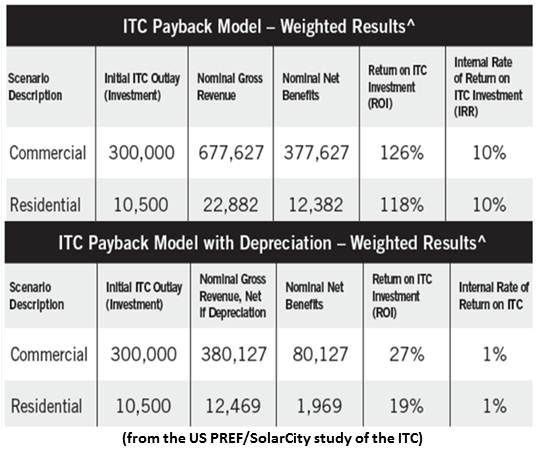The Treasury Department is investigating charges that SolarCity and other third-party solar funds inflated the value of their installations to drive more investment tax credits to their investors.
Insinuations of federal tax benefit abuses are common from anti-renewables forces, but the current charges are represented in part in data from Tax Evasion and Subsidy Pass-Through Under the Solar Investment Tax Credit by University of Colorado economics doctoral candidate Molly Podolefsky.
“Third-party firms generate system prices to report under the ITC which are intended to capture the fair market value of systems,” Podolefsky says. “Over-reporting price allows firms to reap larger tax credits.”
Podolefsky finds “the prices firms report for third-party systems exceed prices of customer-owned systems by 10 percent, or $3,900 per system.” She concludes “that third-party PV firms in California were awarded $25 million in excess ITC tax benefits due to price over-reporting between 2007 and 2011.”
She singles out SolarCity’s “large pricing differential” but also names other third-party ownership (TPO) players like Sungevity and Sunrun.
SolarCity replied to the findings in a blog post, stating that fair market value (i.e., the price the buyer actually paid for the system) must be determined by an independent appraiser. The company goes on to state that its practices follow the IRS guidelines detailed in "Valuation of Solar Generation Assets" by appraiser CohnReznick and adhere to “the 1603 Program’s rules and guidance.”
“My results suggest that SolarCity charges 28 percent more at the mean for a third-party system than it does for a customer-owned system of the same size using the same solar modules. Sungevity prices average 21 percent higher,” writes Podolefsky.
To earn more tax credits for investors such as Google, Morgan Stanley, and U.S. Bancorp, solar providers “may have judged the probability of detection and punishment to be low,” Podolefsky speculates. “SolarCity's swift reversal on pricing of third-party systems [in 2012] suggests the threat of punishment encapsulated in the federal [investigation] was a sufficient deterrent to completely eliminate cheating.”
“That assertion is not only false, but doesn’t make sense,” said SolarCity Communications VP Jonathan Bass. “No one is going to pay an additional dollar for an additional 30 cents of tax benefits.”
Tax equity funds earn an 8 percent to 12 percent annual IRR, according to solar industry investment authorities Sol Systems and NREL. Yet the ITC has been shown to be a profitable investment for taxpayers.

Much of Podolefsky’s data came from the California Solar Initiative (CSI), but using it accurately presented problems. “Of the three large third-party PV firms under investigation for price over-reporting, only SolarCity can be studied using the main empirical methodology,” she acknowledges. “Sunrun cannot be distinguished in the CSI dataset, because it performs all installations through subsidiaries…[and] Sungevity does appear in the dataset, but it operates solely in the third-party market.”
A change to exclude developer costs in the data SolarCity reported to the CSI explains the “swift reversal on pricing,” which Podolefsky attributes to “the threat of punishment,” Bass said. “Without asking us, the student just assumed this represented a sudden change in our pricing. She misunderstands both tax law and the project databases.”
A Barron’s review of 153,628 records from solar contract databases in California and Arizona produced conclusions similar to Podolefsky’s, but also, according to Bass, contained similar misinterpretations of data.
“Any analysis of CSI data as a proxy for fair market value of TPO systems is fundamentally flawed, because CSI does not reflect fair market value,” said GTM Research Senior Solar Market Analyst MJ Shiao.
The result was “a flawed analysis that appeared to show a much greater difference in price (and by implication, grant or tax credit) than actually exists,” according to SolarCity’s blog post.
SolarCity, unlike most of its TPO competitors, “finances, develops and installs the majority of its solar projects.” Its competitors acquire them from third-party contractors. When reporting to databases, “they report the amount they paid the third-party contractor. That is a lower number than the price they sell the system for.”
The Barron’s review was flawed, SolarCity's blog post noted, because, according to the CSI FAQ, “the current dollars per watt data available for CSI projects present difficulties when comparing host customer-owned and third-party-owned systems. […] The reported costs for host customer-owned systems are simple, as they reflect the purchase price inclusive of parts, labor, permitting fees, overhead, and profit. Third-party-owned systems, on the other hand, are reported in a variety of ways, and may also capture costs for additional services.”

Pressure on SolarCity and the other funds ratcheted up with a letter from Senator Jeff Sessions (R-Alabama) to Treasury. Citing the Barron's article, Sessions asked what the Department will do “to prevent the use of fraudulently inflated proxy data.”
SolarCity “appears to use a more complex measurement than some other solar installers,” Sessions quoted Barron's as saying. “While analysts estimate that SolarCity’s costs are about $4 per watt, the company’s reported fair market value often exceeds $6.”
“Recent IRS guidance has called into question the propriety of certain common solar financing practices,” said Mintz Levin clean technology practice Chair Tom Burton. “Whether SolarCity is doing it right or not, I don’t know,” Burton said. “But people are asking questions.”
Penalties may apply in the TPO arrangements, according to Burton, and there could be criminal liability under IRS rules and violations of federal securities laws if securitizations were involved.
Bass is confident SolarCity will be vindicated by the investigation. “This will disappoint our competitors and detractors in the fossil industry, but we have followed all the rules of the ITC and 1603 programs and the pricing guidance that the Treasury Department has provided.”
Some $18 billion in Section 1603 cash grants were awarded through the 2009 American Recovery and Reinvestment Act and more than $4.3 billion went to solar, according to Forbes. With billions in funds still available, “this is an issue that needs to be examined and resolved.” None of the sources consulted for this piece disagreed with that.



